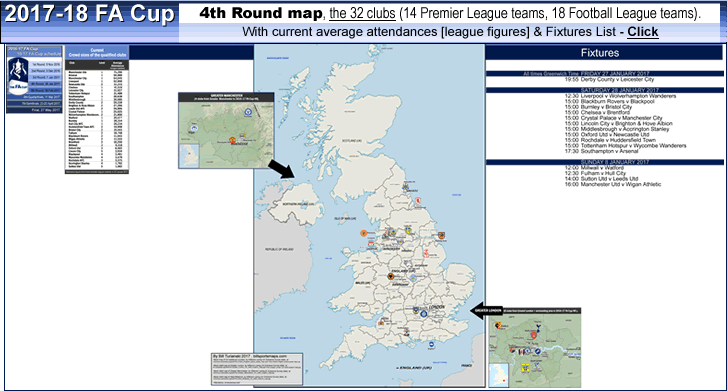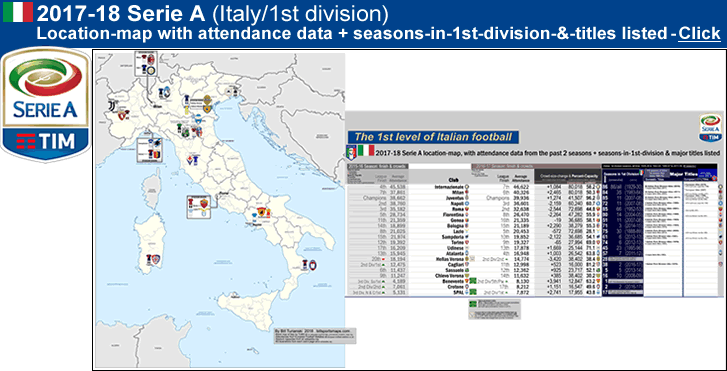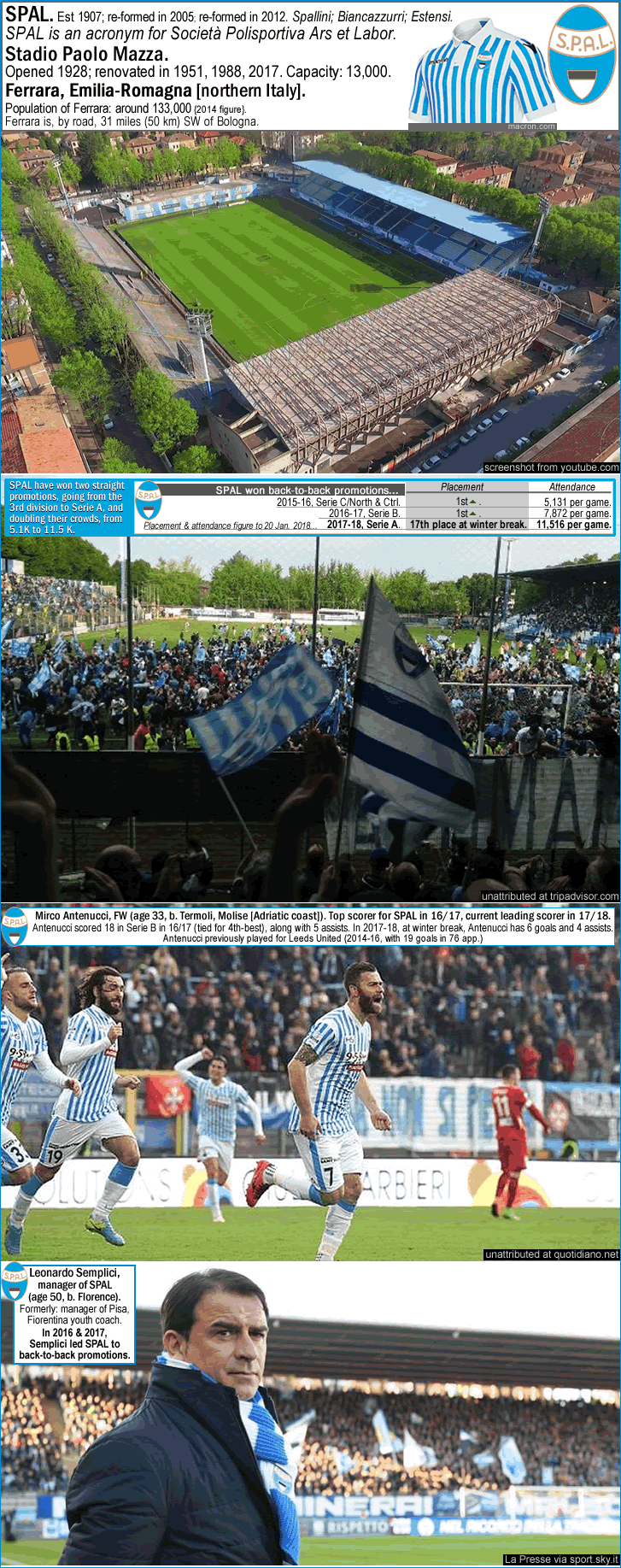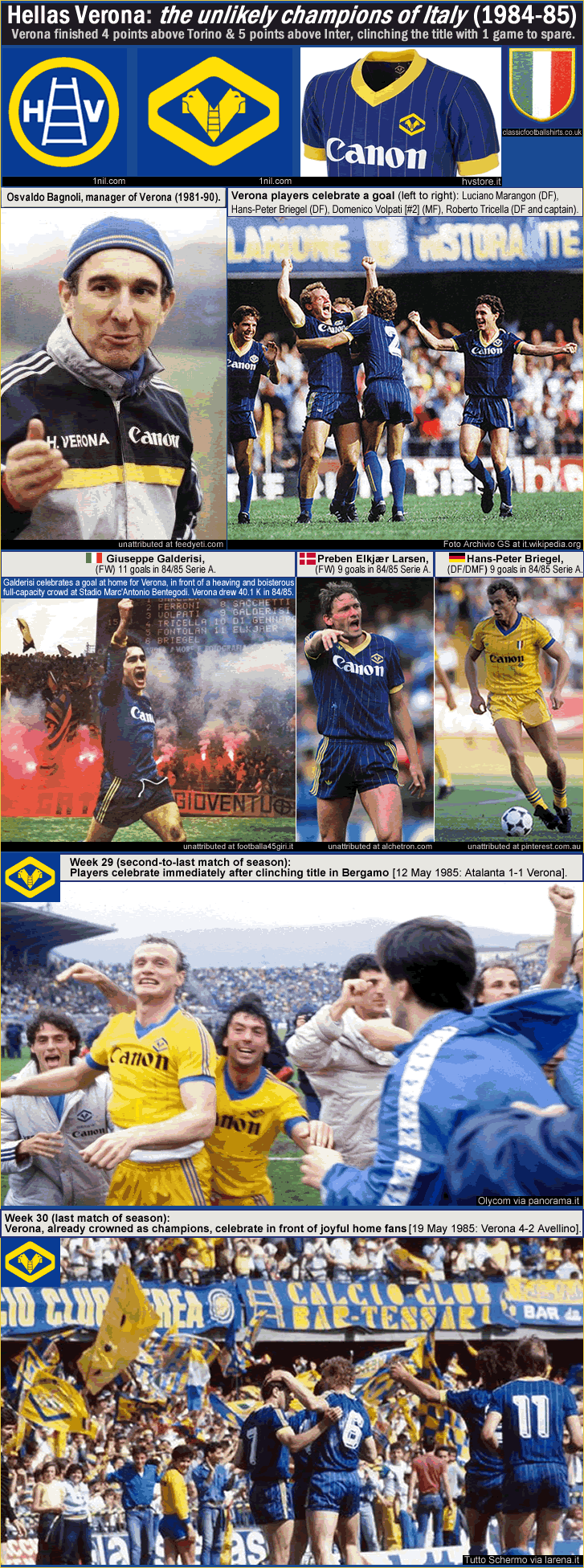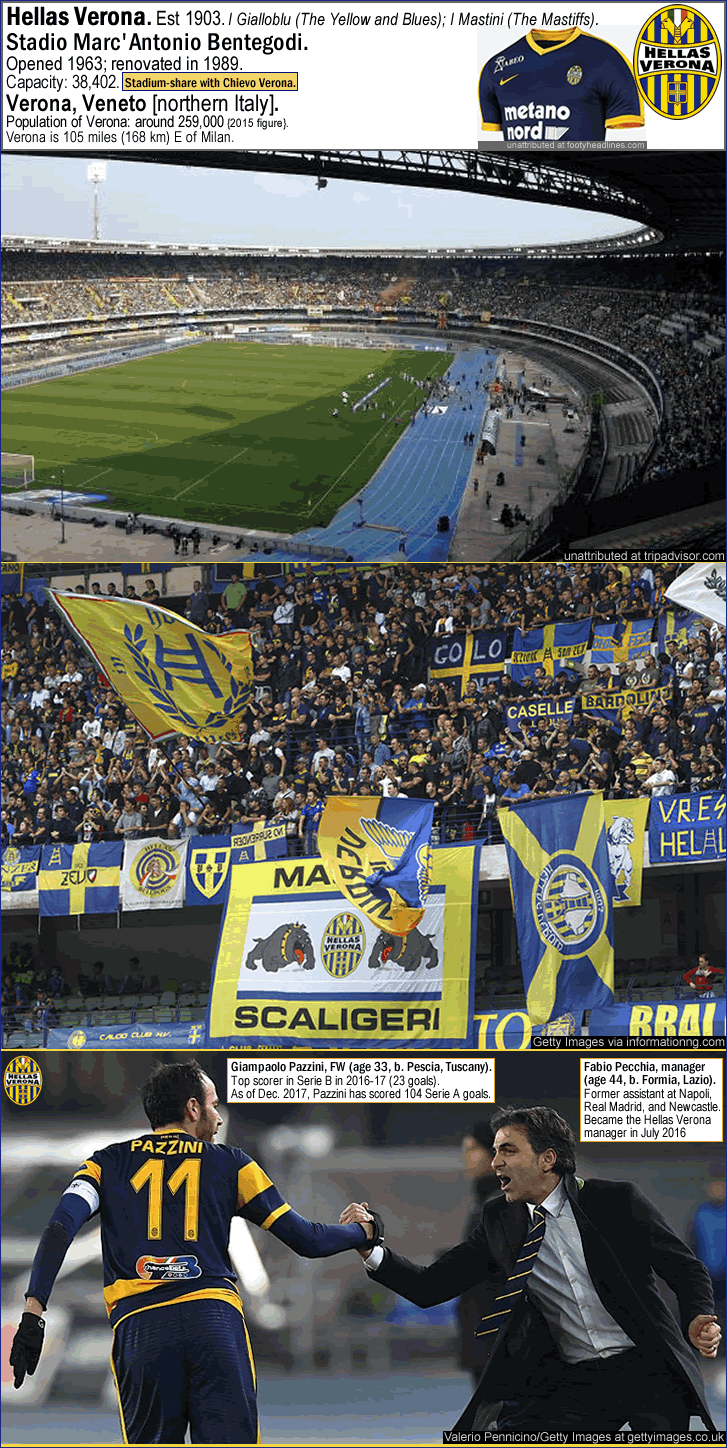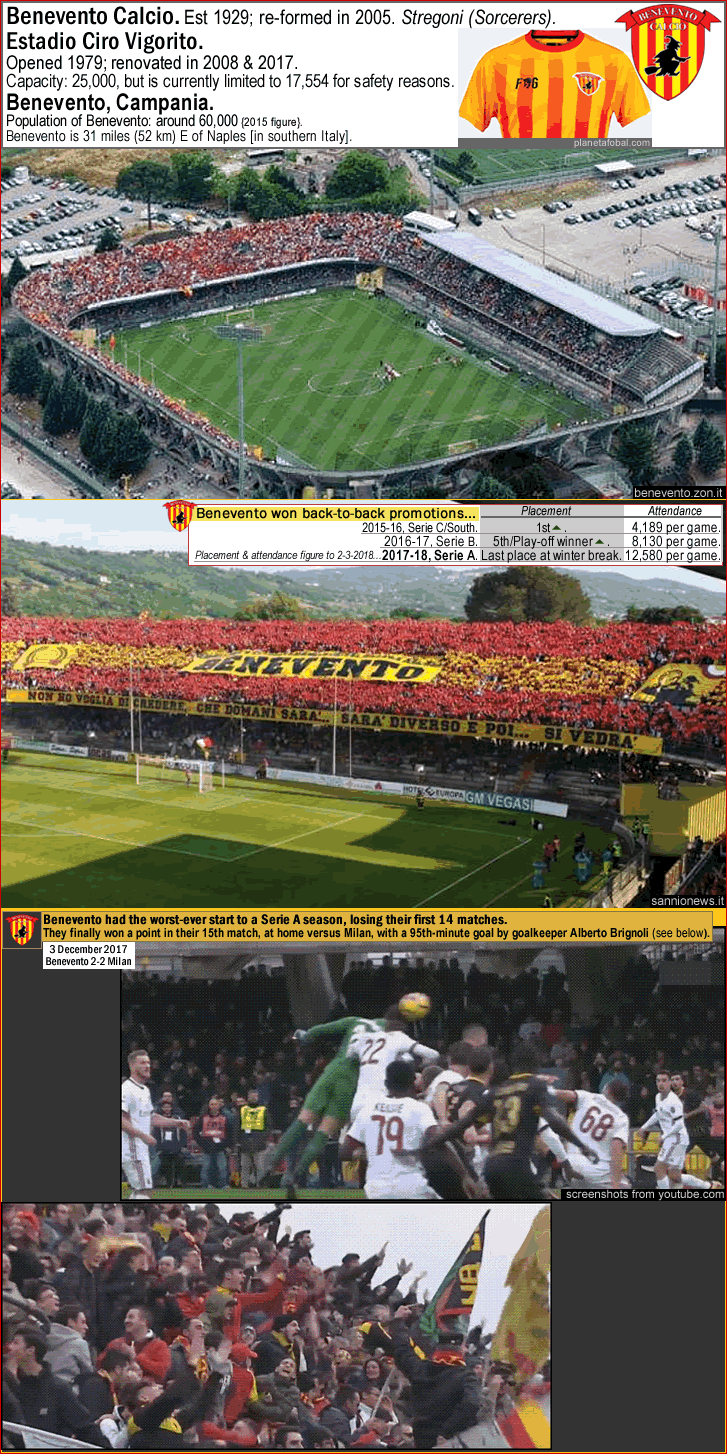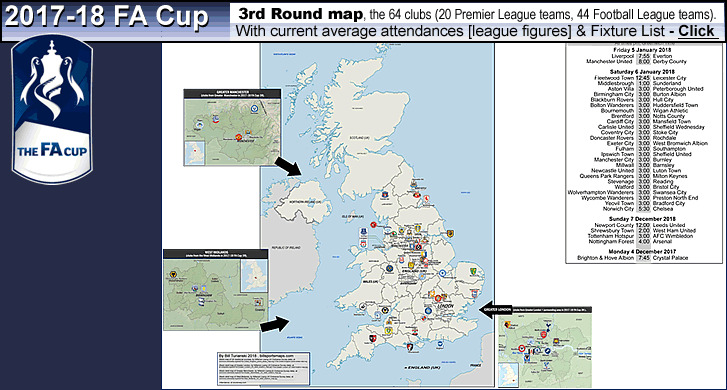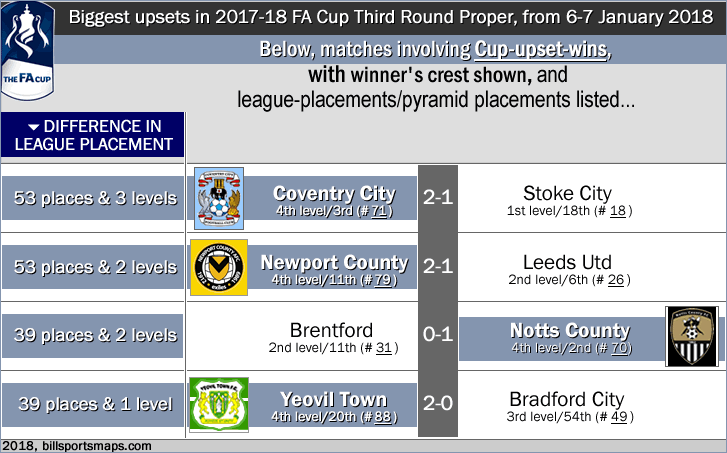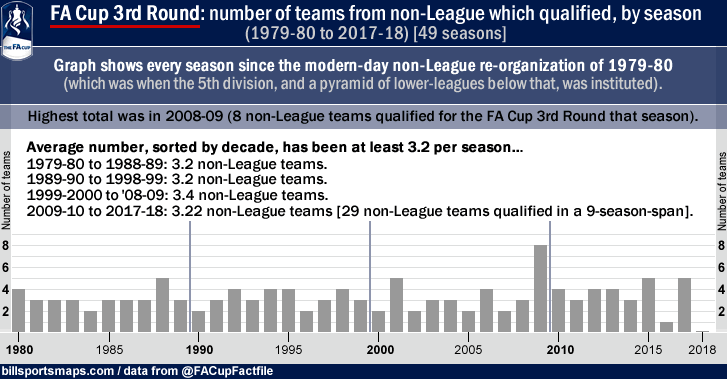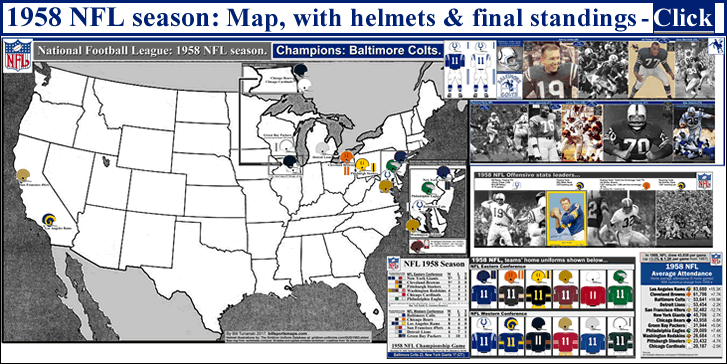
NFL 1958 season, map with helmets and final standings; champions: Baltimore Colts./+ 1958 NFL attendance data
…
…
By Bill Turianski on 30 January, 2018; twitter.com/billsportsmaps.
Links…
-1958 NFL season
-1958 NFL Championship Game (en.wikipedia.org).
-1958 NFL season (pro-football-reference.com).
-1958 NFL Teams [illustrations of uniforms of the 12 NFL teams of 1958] (gridiron-uniforms.com).
The map… The map, done in the style of 1950s newspaper graphics, shows the primary helmets and jerseys worn by the 12 NFL teams of 1958. Final standings for the 1958 NFL season, along with team-colors worn that season, can be seen at the lower-right of the map page. Home helmets and jerseys are shown alongside the standings. At the lower-right-corner of the map page there is a small section devoted to 1958 NFL attendance data (also see attendance section further below). At the top-right of the map page is a section devoted to the 1958 NFL champions, the Baltimore Colts (also see next 12 paragraphs and the illustration below). And at the far-right-hand-center of the map page, are 1958 Offensive leaders in the following categories: QB Rating and TD Passes: Johnny Unitas, Colts. Passing Yards: Billy Wade, Rams. Rushing Yards and Rushing TDs and Total Yards from Scrimmage and Total TDs: Jim Brown, Browns. Receiving Yards: Del Shofner, Rams.
- Johnny Unitas led the 6-year-old Colts to the 1958 NFL title, over the NY Giants 23-17 (first-ever OT game)
Johnny Unitas, the son of Lithuanian immigrants, was a Pittsburgh-born graduate of Louisville University. At college, he played the dual role of QB and Safety for the Redbirds. Unitas had been a 9th round selection by his hometown team, the Pittsburgh Steelers, in 1955. But Unitas was cut by the Steelers in the ’55 preseason, with Steelers coach Walt Kiesling under the impression that Unitas was not smart enough to run an NFL offense, even though Kiesling (duh) never even let Unitas take one snap during the entire preseason. So Unitas worked in construction jobs in Pittsburgh in the latter half of 1955, to support his family, and he played semi-pro football for 6 bucks a game.
In the following year of 1956, Unitas got a second chance, when, after a successful tryout, Weeb Ewbank and the then-4-year old Baltimore Colts signed him. A few games into the ’56 season, backup-QB Unitas got his shot, when starting QB George Shaw was injured in the 4th game; and in 1956 the Colts finished 5-7. The next year, 1957, with Unitas now the starting QB, the Colts went 7-5…this was the team’s first winning season. And 1957 was also the first time the Colts drew above 40 K per game (attendance in ’57 for the Colts increased by 6.9 K, to 46 thousand per game). In the following season of 1958, the Colts shot out of the gate, winning their first 4, and the fans continued to flock to Baltimore’s Memorial Stadium. The Colts saw an eye-popping 16.9-K-increase in crowd-size, to 53.6 K (which was an impressive 93 percent-capacity), at the 57.5-K-venue [which they shared with MLB's Baltimore Orioles]. The Baltimore Colts (a small-market team) had the third-best attendance in the NFL in 1958 (see attendance section on the map-page, as well as the league-attendance section further below).
So in 1958, the Colts won the Western Conference, going 9-3. The Colts had the league’s most potent offense, averaging 31.75 points per game. Unitas led the league in passing yardage and passing TDs (2,007 yards and 19 TDs). Unitas’ three main targets in ’58 were Hall Of Famers Lenny Moore (HB) and Raymond Berry (End/WR), as well as Jim Mutschellar (TE). Lenny Moore, who was a running back and not a wide receiver, gained a league-second-best 938 yards receiving, while Raymond Berry gained 724 yards receiving (which was the 4th-best that season), and TE Jim Mutschellar gained 504 yards receiving. The Colts ground game was spearheaded by FB Alan Ameche and HB Lenny Moore: Ameche gained a league-2nd-best 791 yards (second only to MVP Jim Brown of the Browns), while Moore ran for 598 yards. And Lenny Moore also had a league-best 1,536 yards from scrimmage. So, the Colts offense was dominant in ’58, and the Colts defense was second-best in that year (behind only the Giants). The Colts’ front four featured two future Hall of Famers: DE Gino Marchetti, and DT Art Donovan. And the Colts had the most prolific secondary that season, with 35 interceptions (including 8 pick-offs by both Ray Brown and Andy Nelson, and 7 by Carl Taseff). The dominance that the Colts had in the NFL Western Conference in 1958 can be seen in the fact that the Colts had the league’s best point-differential by far: +178 pd (which was almost triple the Giants’ pd, of +63).
The Colts had clinched the NFL Western Conference title in the 10th week, and thus, crucially, were able to keep key players rested on the bench for their last 2 regular-season games (which they lost). The Colts won the West by a game, over the 8-4 Chicago Bears and the 8-4 LA Rams. That meant the Colts would face the Eastern Conference champs, the 9-3 New York Giants, who featured a tough defense led by DE Andy Robustelli and LB Sam Huff, and a potent offense featuring the wily 37-year-old-veteran QB Charlie Conerly, star Halfback/End Frank Gifford (the 1956 league MVP), and Flanker Kyle Rote.
But, to get to the 1958 title game, the Giants had to play an extra game – an Eastern Conference tiebreaker – versus the Cleveland Browns, and New York had beaten Cleveland 10-0, a week before the Championship game. So the Colts players were much more rested than the Giants players. The Giants had won the title 2 seasons before (in 1956), 47-7 over the Bears, on a frozen surface at Yankee Stadium. Two years later, for this Giants versus Colts title game of 1958, game-time conditions were much better: 44ºF (7ºC) and dry, with virtually no wind. About 20,000 Colts fans from the Baltimore-area had made the trip up to Yankee Stadium for the game, by car, bus, and specially organized trains. There was a full-capacity crowd of 64,185 on hand at Yankee Stadium. The Colts were 3.5 point favorites (probably due to both the Colts’ offensive capabilities, as well as the Colts being the more rested squad).
Because of the sheer excitement that the closely-fought game caused, and because it was the first NFL championship game to be broadcast nationally on television (on NBC, to an estimated audience of 10.8 million homes), and because of its pivotal timing in the late 1950s (just as the medium of television had begun to broadcast pro sports nation-wide), the Colts versus the Giants in the 1958 NFL title game came to be known as The Greatest Game Ever Played. From youtube.com, ‘The Greatest Game Ever: 1958 NFL Championship‘ (5:33 video uploaded by vslice02 at youtube.com).
The 1958 NFL title game was the first NFL game, play-off or otherwise, that went to sudden-death overtime. It featured two hard-nosed teams with offenses that had the capability to move the ball down the field with lightning-quick efficiency. The Giants were coached by Arkansas graduate Jim Lee Howell, who coached the Giants from 1954 to 1960. Howell’s two main assistant coaches are both in the Pro Footballl Hall of Fame – the Giants’ defensive coach in 1958 was future Cowboys’ head coach Tom Landry (whom Howell had converted from a Giants LB to defensive coordinator 2 years previous in 1956); the Giants’ offensive coach in 1958 was future Packers’ head coach and football demi-god Vince Lombardi (whom Howell had hired from West Point, where Lombardi was Army’s offensive line coach 4 years previous in 1954). The Colts were coached by Weeb Ewbank, who had got his pro coaching start under Paul Brown at Cleveland, and was hired as the Colts’ head coach in their second season (in 1954). Ewbank gave the Colts an unusual pre-game talk… “Not known for emotional speeches, Weeb gave one to his men before the game, reminding them of how they were unwanted by other teams. ‘Unitas, Pittsburgh didn’t want you. We got you for a 75-cent phone call. Lipscomb, the Rams got rid of you. We got you for a hundred bucks. Berry? One leg shorter than the other, with bad eyesight to boot. … So you should win this game for yourselves’…” {-Excerpt from goldenrankings.com/[1958 NFL Championship Game]).
The Giants/Colts 1958 title game had multiple big plays, swift scoring drives, and changes in momentum – the biggest when, in the 3rd quarter with the Colts leading 14-3, the Giants stopped Baltimore on a fourth-and-goal-to-go on the 1 yard-line, for a 4-yard-loss (see color photo in the illustration below, where Unitas is about to hand off to Alan Ameche for that 4-yard-loss). Then the Giants went 95 yards for a TD in 4 plays. That drive was highlighted by a 86-yard pass play from deep within the Giants’ own territory: QB Charlie Conerly threw to WR Kyle Rote downfield left-to-right across the middle. Rote broke a tackle at mid-field, but then he fumbled when hit from behind at the Colts’ 25…Giants RB Alex Webster, who was trailing the play, recovered the fumble and ran it all the way to the 1-yard line. RB Mel Triplett then scored on a 1-yard TD run, and the Giants were back in it, now behind by only 4 points, at 14-10. The Giants then went ahead 17-14 early in the 4th quarter – Conerly’s 46-yard completion to TE Bob Schnelker set up his 15-yard TD pass to Frank Gifford.
In the dying minutes of the 4th quarter, the Colts took over with 1:58 to go, at their own 14-yard line (after a Giants punt). Unitas then put together one of the most famous drives in football history. After two incomplete passes, Unitas made a clutch 11-yard completion to Lenny Moore on third down. After one more incompletion, Unitas threw three straight passes to Raymond Berry, moving the ball 62 more yards, to the Giants’ 13-yard line (Berry had 12 receptions for 178 yds, the most yards from scrimmage in the game, and an NFL title game record.) A 20-yard FG by K Steve Myhra with 7 seconds left sent the game into sudden-death overtime…the first overtime game in NFL history. In OT, the Giants won the toss but failed in their first possession. Then Unitas and Baltimore drove 80 yards on 13 plays on the tired New York defense, and, aided by a key block at the goal line by TE Jim Multschellar, the Colts scored on a 1 yard TD by Alan Ameche, to win the game 23-17. Here is something that has went a little bit forgotten amidst all the hoopla surrounding this game…Johnny Unitas had called all 13 plays of the winning drive.
The 1958 NFL title game became known as The Greatest Game Ever Played…

Photo and Image credits above -
Illustrations of Colts and Giants 1958 helmets from gridiron-uniforms.com/[1958]. Game program, unattributed at goldenrankings.com. Screenshot of video [Yankee Stadium, exterior shot], image from video uploaded by NFL at youtube.com, ‘The Greatest Game Ever Played’ 1958 NFL Championship: Colts vs. Giants. Photo of Unitas in pocket, photo unattributed at chatsports.com. Raymond Berry diving catch in ’58 title game, photo by Hy Peskin/Getty Images at gettyimages.com. Screenshot of Giants D about to stop Ameche on 4th-and-goal, unattributed at sportsblogmovement.wordpress.com. Photo of Unitas passing long, late in game, from baltimorepostexaminer.com. Unitas watches after handing off to Alan Ameche (winning TD in OT), photo by Neil Leifer at neilleifer.com. Colts fans carry Ameche off the field as the goal-posts are torn down, photo by Neil Leifer/Sports Illustrated via darkroom.baltimoresun.com. Fans carry Ameche off the field, screenshot of video uploaded by NFL at youtube.com.
The broadcast of the game by the NBC television network is credited with growing, almost overnight, the fan interest in the NFL. The 1958 NFL Championship Game marked the start of the popularity-surge for the NFL… a popularity-surge that has not abated to this day. As pro football historian Bob Carroll notes in his book When the Grass Was Real …’The next morning…for the first time in history, the National Football League was the number-one topic at watercoolers from sea to shining sea. Among the oohs over Johnny Unitas’s passes and the ahhs over Sam Huff’s tackles came many plaintive wonderings why “our town” didn’t have its own pro football team.’…{end of excerpt from page 12 of When the Grass Was Real, by Bob Carroll, published in 1993 by Simon and Schuster, available at amazon.com here}.
-Video: The Greatest Game Ever Played – 1958 NFL Championship Highlights – Colts vs Giants (12:31 video [fuzzy color video] uploaded by Savage Brick Sports at youtube.com).
-From Golden Rankings, 1958 NFL Championship Game, Baltimore Colts @ New York Giants [illustrated article in chart form] (goldenrankings.com).
1958 Baltimore Colts: 6 All-Pro players; plus 6 from the ’58 Colts that were later inducted into the Pro Football Hall of Fame.
Note: All-Pro, below, means: 1958 AP, 1st team.
-Johnny Unitas: 1958 All-Pro (QB), and 1958 MVL (AP & UPI & Bert Bell Trophy); Unitas was inducted to the HoF in 1979.
-Gino Marchetti: 1958 All-Pro (DE); Marchetti was inducted to the HoF in 1972.
-Jim Parker: 1958 All-Pro (OT); Parker was inducted to the HoF in 1973.
-Raymond Berry: 1958 All-Pro (WR); Berry was inducted to the HoF in 1973.
-Lenny Moore: 1958 All-Pro (HB); Moore was inducted to the HoF in 1975.
-Gene Lipscomb: 1958 All-Pro (DT).
-Art Donovan: (DT) inducted to the HoF in 1968.
-Weeb Ewbank: (Head coach of Colts from 1954-62); Ewbank was inducted to the HoF in 1978.
…
1958 NFL attendance figures, and notes on stadia.
In 1958, the NFL was in the midst of its steadily-increasing popularity, and broke 3 million total attendance for the second straight year. There were 3,132,346 tickets sold for the 72 regular season games of the 1958 NFL season, making an average attendance of 43,504. The public were being captivated by the NFL, and the turnstiles told the tale: in a 5 year span, the NFL increased its average attendance by a staggering 11.1 thousand per game…in 1954, the NFL averaged 32.4 K; five years later, in 1958, the NFL was averaging 43.5 K.
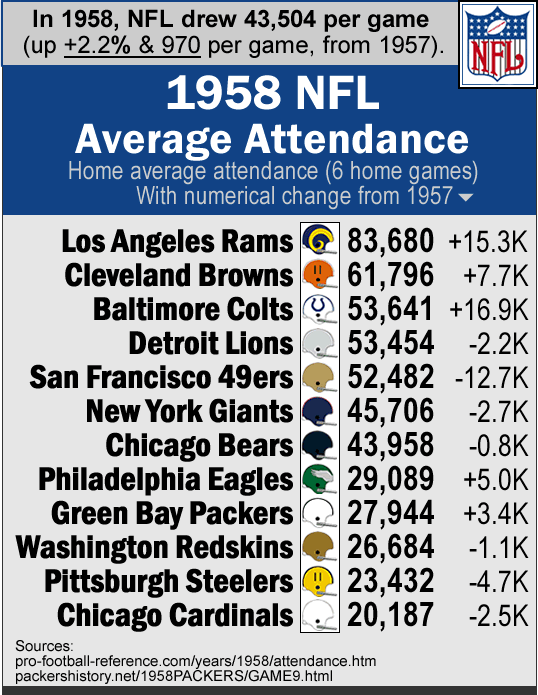
Credits above – sources for figures: pro-football-reference.com/years/1958/attendance.htm; packershistory.net/1958PACKERS/GAME9. Helmet icons: gridiron-uniforms.com/[1959]. Chart: billsportsmaps.com.
In 1958, the highest drawing NFL team was, once again, the Los Angeles Rams, who drew an astounding 83.6 thousand per game. Second-best-drawing team was the 9-3 Cleveland Browns (at 67.1 K). The Baltimore Colts drew third-best (at 53.6 K [which was a league-2nd-best 93.1-percent-capacity; only the Packers at their Green Bay venue filled their stadium better]). Two more teams drew above 50-K: the reigning-champs the Detroit Lions (at 53.4 K), and the San Francisco 49ers (at 52.4 K). And two more teams drew in the mid-40-K-range: the New York Giants (45.7 K) and the Chicago Bears (43.9 K). So there you go: in 1958, these were the 7 NFL teams that were drawing big-time crowds…Rams, Browns, Colts, Lions, 49ers, Giants, Bears. Then there was a rather large divide between those 7-high-drawing teams, and the other 5 NFL teams of 1958.
1958 NFL attendance: A chasm of 12-thousand-per-game separated the top 7 draws (see above) and the 5 lower-drawing teams (see below).
Just as the NFL was becoming more popular circa 1958, there were still 5 franchises that were under-performing at the turnstile. Each of these low-drawing NFL teams back then had their own reasons for drawing poorly. The Chicago Cardinals drew so poorly because the team was doomed to being the after-thought-team in the Windy City, thanks to the Bears’ predominance there (and so the Chicago Cardinals moved to St. Louis two years later, in 1960). The Pittsburgh Steelers were just so consistently bad back then (or at best, mediocre), and were bad for so long, that their crowd-sizes were perpetually stuck in the mid-20-K-range. But also, the aging Forbes Field, which the Steelers rented from MLB’s Pittsburgh Pirates, was pretty decrepit at this point and had a somewhat small capacity of around 41,000. Washington, like the Steelers, also had to rent from an MLB team and play in an outdated venue; plus, Washington in the late-’50s was in the midst of a 13-year-slump without a winning season, and crowds at Griffith Stadium had plateaued to the point that they were drawing only 1.2 K better than they were eight seasons earlier in 1950 (Washington drew only 25.4 K in ’50; and 8 years later in ’58 they were only drawing slightly better at 26.6 K). So, in an 9-season-span (1950 to ’58), while the NFL as a whole increased its average attendance by over 14 thousand per game, Washington increased their crowds by only twelve-hundred or so per game.
The Packers’ low attendance in 1958 is a complicated issue. First off, one would expect a drop-off in attendance for the Packers in ’58, because 1958 was the absolute worst season the Green Bay Packers ever had (1-10-1). The Packers were the only NFL team that had two venues, and from 1933 to 1994, the Packers played 2 or 3 games each season in Milwaukee (they played 4 games in Green Bay and 2 home games in Milwaukee during the 1958-60 time period). In 1958, the Packers were not able to draw higher than the 29.7 K they averaged that season for two reasons: small capacity in their new venue in Green Bay (City Stadium (II), which opened in 1957), and low attendance in Milwaukee. The Packers’ City Stadium (II) [now called Lambeau Field] only had a capacity of 32,500 back then. In 1958, the Packers had the league’s best percent-capacity figure, that is, for their four Green Bay home games. The Packers played to an average of 30.8 K in their 4 home games in Green Bay (which was a solid 94.8 percent-capacity). But in their two home games in ’58 at Milwaukee County Stadium (which had a much larger capacity of 43.7 K), the Packers drew poorly: 24.5 K v Rams in October and then only 19.7 K v 49ers in late November. The Packers fortunes would improve vastly with the arrival of Vince Lombardi in the following season of 1959, and the team would, um, pack even more fans in their soon-to-be-expanded stadium, and by 1961, the Packers were back to their title-winning ways. And despite being located in the smallest NFL market by far, the Green Bay Packers have been playing to basically-full-capacity ever since then. And after the 1994 season, the Packers’ organization came to the conclusion that, because demand for tickets was so great, they no longer needed to play a few of their games each season in Milwaukee. But as early as 1958, looking at the poor support Milwaukee residents gave the (admittedly bad) ’58 Packers, one could say that the small-town Green Bay Packers could already could stand on their own, without the crutch of a big-city venue.
There was one more team that was drawing significantly below the NFL average of 43-K in 1958, and that was the Philadelphia Eagles (see next two paragraphs).
1958: Philadelphia Eagles move into Franklin Field at the University of Pennsylvania…
Franklin Field dates back to 1895, with its current structure installed in the 1920s. When the Eagles played there (for 13 seasons, from 1958-70), it had a capacity of 60 thousand. It was, and still is, the home of the Ivy League college football team the Penn Quakers. It was also the home of the annual Army-Navy Game from 1899-1935. As the Stadiums of Pro Football.com site says, “Franklin Field is the answer to a trivia question that even the most dedicated NFL fans might not know. It is the oldest football stadium in the country.” {-Quote from Frankiln Field at stadiumsofprofootball.com.} The Eagles move to Franklin Field was beneficial purely because it was a move from a baseball park to a venue designed for rectilinear sports like gridiron football. The Eagles moved into Franklin Field not as renters (the U. of Penn is a not-for-profit organization), but the Eagles donated about $75-to-100-K per year to stadium upkeep. However, the Eagles were not allowed to profit from sales of food and drink, or from parking fees. So, it was not an ideal set-up, and the Eagles later jumped at the opportunity to move into the city’s new multi-purpose venue, Veterans Stadium, in 1971 (which, of course, was also the home of the Philadelphia Phillies MLB team [from 1971-2003]).
Prior to 1958, the Eagles, like the Steelers and like Washington, had played in an MLB ballpark that was antiquated. Since 1942, the Eagles had played at Connie Mack Stadium [aka Shibe Park], which only had a capacity of around 39,000, unless temporary bleachers were installed (as the Eagles were doing during their dual-championship-era of 1948 and ’49). And, like Pittsburgh and like Washington, the Eagles circa the mid-to-late-1950s were also bad, so this contributed to their small crowds. The Eagles drew worst in the league the year before, in 1957, when, in their last season at Connie Mack Stadium, and as a 4-8 team, they drew only 21.6 K. The next year (1958), with the move over to Franklin Field, the Eagles increased their crowd-size by 7.4-K-per-game (to 29.0 K per game). Their attendance had increased thanks to the venue-change, and despite the fact that Eagles were in a re-building mode and were really bad in ’58 (finishing last in the East, at 2-9-1). The next season of 1959, the Eagles, under aging-but-still-very-effective QB Norm Van Brocklin, vastly improved (to 7-5), and that helped to draw 10-thousand-more per game to Franklin Field (the Eagles drew 39.2 K in ’59). And then in 1960, the Philadelphia Eagles would be NFL champions. These days, the Eagles draw very well and have no attendance issues (well, other than a disproportionate amount of unruly fans).
…
Helmet and uniforms changes for 1958 NFL…
1958 was the second year that the NFL had mandated that all home teams were to wear their dark jersey, and all road teams were to wear their white (or light-colored) jersey. This was to ensure that television viewers watching NFL games on black-and-white TVs would not have trouble differentiating between the two teams.
Below: Washington’s ‘feather-helmet’ (worn from late 1958 through to 1964; replaced by the feathered-spear helmet)…

Photo and Image credits above – gridiron-uniforms.com/[Washington 1958]; helmet photos from helmethut.com.
-In 1958, Washington introduced the ‘feather-helmet’, which was worn for the last two games of the season. Washington was the fourth NFL team to introduce a helmet-logo {here are the first three helmet-logos in the NFL}. The feather-helmet was an unusual back-of-the-helmet-oriented logo, of a large feather, in pale-red-and-white, on a brownish-burgandy helmet {1958 Washington}. {Here is a photo from 1960, Washington v Eagles, that shows the feather-helmet from several angles.} The weird feather-logo helmet lasted 7 years, and that was replaced in 1965 by a diagonally-positioned gold-spear-with-feather logo {1965 Redskins uniforms}. Washington’s feather-helmet had the same problem that the original Colts’ horseshoe helmet (of ’54) had…the logo was oriented to the back of the helmet, making it hard to see from the front.
-In 1958, the Chicago Cardinals ditched their alternate red-helmets, wearing only a (plain) white helmet {Cardinals 1958}. The Cards kept the plain white helmet again in ’59, and then upon moving to St. Louis in 1960, introduced their now-iconic frowning-cardinal-head helmet, which in my opinion is one of the best looking helmets ever made {1960 Ken Gray game-worn Cardinals helmet {helmet-hut.com)}.
-In 1958, the Los Angeles Rams ditched their yellow/orange [aka gold] jerseys, which the Rams had worn for some games in every one of their 14 previous seasons (going all the way back to their last year in Cleveland {1945 Cleveland Rams}). {Here is what the Rams looked like in 1957, when they were the only NFL team to sport 3 different jerseys; here were the rather plain 1958 Rams uniforms.} {Here is a photo of Rams HB Frank Arnett from 1958, on the bench during a Rams game at the LA Memorial Coliseum. By the way note, in the background of this photo, the huge crowd at the Coliseum that day; again, this was when the Rams were drawing 83 thousand per game, which was 40 thousand per game more than the league-average.} The Rams have worn yellow/orange jerseys a few times in the modern era {throwback-uniforms in 1994, and an alternate uniform (color rush) in 2014}.
-In 1958, the Green Bay Packers did not wear any gold in their uniforms (no yellow/orange gold or metallic-gold). Green Bay, in ’58, for some strange reason, only wore dark-forest-green-and-white at home, and wore white-and-dark-blue on the road…and their helmet was a plain white helmet with a dark-green center-stripe. This Packers’ alternate helmet-and-color-scheme of white-and-dark-forest-green was worn for parts of 3 seasons (1956, ’57, ’58). Green Bay’s 1958 gear was the only season in the Packers’ history, besides {1922}, when any shade of gold was not in their colors. It was also, coincidentally or not, the Packers’ worst season ever [1-10-1]. {Here are the dreary and eminently forgettable uniforms of the 1958 Green Bay Packers.} {Here is the only color image I could find of this shade of Packers green: photos of Forrest Gregg and Bart Starr from pre-season 1956.} It really is a forgotten period in the history of the Packers. By the way, if you look closely at the ’58 Packers home jersey you can see that the green had a bit of blue in it: a dark-bluish-grey-shade-of-green (ie, forest-green), not the simply-dark-green they have worn since 1959. So, after their strange 3-year-experiment with white helmets and a weird shade of dark-bluish-green, in 1959, with the arrival of coach Vince Lombardi, the Packers began wearing their current color-scheme of gold (yellow-orange) and plain-dark-green. A couple years after that, the Packers’ introduced their football-shaped-G-logo. The Packers’ helmet logo was introduced in 1961…which just so happens to be the year that the Packers started winning NFL titles again.
___
Photo and Image credits on map page…
Baltimore Colts…
Colts’ Raymond Berry-style helmet w/ butterfly-facemask [reproduction of helmet from 1960-63 era], from ebay.com. Johnny Unitas, photo [from commemorative issue of Baltimore Sun, following Unitas' death in 2002], photo unattributed at nflfootballjournal.blogspot.com/[Johnny Unitas feature]. Unitas and Colts offensive line after a snap, Life magazine photo [from 1960], photo unattributed at grayflannelsuit.net/blog. Jim Parker [segment of 1959 Topps card], from ebay.com. Gino Marchetti [photo from 1958 title game], photo unattributed at sportsecyclopedia.com/nfl/[Baltimore Colts]. Raymond Berry [photo from 1958 title game], photo unattributed at pinterest.com. Gene Lipscomb [photo circa 1959], photo unattributed at helmethut.com. Lenny Moore [photo circa 1959], photo unattributed at nflpastplayers.com/lenny-moore. Art Donovan, photo [from 1958 preseason] by Baltimore Sun at baltimoresun.com. Alan Ameche [photo from 1958 title game], photo unattributed at pinterest.
1958 Offensive stats leaders…
Johhny Unitas (Colts) [photo from 1958 title game], photo unattributed at chatsports.com. Billy Wade (Rams) [1960 Topps card], from footballcardgallery.com. Jim Brown (Browns), [action-photo from 1958 game v Steelers], photo by Diamond Images/Getty Images via gettyimages.co.uk. Del Shofner [photo from 1958 game v Colts], photo by Al Paloczy/The Enthusiast Network/Getty Images at gettyimages.com.
…
Map was drawn with assistance from images at these links…
48-state-USA/southern Canada, worksheeto.com/post_50-states-and-capitals-printable-worksheet.
Section of Mexico, as well as coastlines-&-oceans, lib.utexas.edu/maps/hist-us.
-Thanks to the contributors at pro-football-reference.com
-Thanks to the contributors at NFL 1958 season (en.wikipedia.org).
-Thanks to pro-football-reference.com and to packershistory.net for attendance data from 1958; thanks to Mike at sports-reference.com/feedback for swift reply and correction of Packers’ attendance discrepancy, of 1958 week 9 game, at pro-football-reference.com.
Special thanks to Tim Brulia, Bill Schaefer and Rob Holecko of The Gridiron Uniform Database, for giving billsportsmaps.com the permission to use football uniforms illustrations from Gridiron Uniform Database {GUD}.
